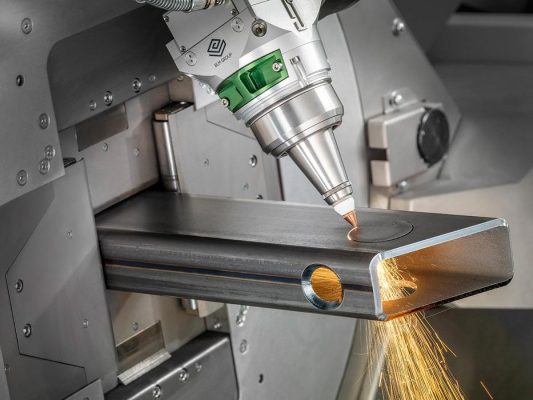pipe laser cutting price calculation
Pipe laser cutting is a precision manufacturing process that uses a focused laser beam to cut through various materials, including pipes. The price of pipe laser cutting can vary significantly based on several factors. Here’s a breakdown of the key elements that influence the cost:

Factors Affecting Pipe Laser Cutting Price
- Material: The type and thickness of the material play a crucial role. For example, stainless steel is generally more expensive to cut than mild steel.
- Pipe Diameter and Wall Thickness: Larger pipes and thicker walls require more processing time and energy, leading to higher costs.
- Cutting Complexity: Intricate patterns or precise tolerances can increase the cutting time and complexity, affecting the price.
- Quantity: Larger quantities often result in economies of scale, leading to lower unit costs.
- Laser Power: The power of the laser machine determines its cutting speed and capacity. Higher-powered lasers can cut thicker materials more efficiently but are generally more expensive to operate.
- Machine Efficiency: The efficiency of the laser cutting machine itself can impact the overall cost. Newer, more advanced machines may be more efficient, leading to lower operating costs.
- Labor Costs: The cost of labor involved in preparing the pipes, operating the machine, and handling the finished products can vary depending on the location and the company’s labor rates.
- Overhead Costs: Overhead expenses, such as rent, utilities, and insurance, also contribute to the overall cost.
Obtaining a Precise Quote
To get an accurate price estimate for your pipe laser cutting project, it’s best to consult with a reputable laser cutting service provider. They can assess your specific requirements, provide a detailed quote, and offer valuable advice on optimizing your design for efficient cutting.
When requesting a quote, be sure to provide the following information:
- Material type and grade
- Pipe dimensions (diameter and wall thickness)
- Desired cutting pattern or design
- Quantity required
- Any special tolerances or surface finishes
By understanding these factors and providing the necessary information, you can obtain a more accurate and relevant price quote for your pipe laser cutting project.
Pipe Laser Cutting Quality: A Comprehensive Guide
Pipe laser cutting has revolutionized the manufacturing industry, offering precision, efficiency, and high-quality results. The quality of the cut depends on several factors, including the laser type, machine setup, material properties, and operator skill.
Key Factors Affecting Pipe Laser Cutting Quality
-
Laser Type:
- Fiber lasers: Often preferred for their high power density and efficiency, especially for cutting thicker materials.
- CO2 lasers: Suitable for a wider range of materials, including plastics and non-metals.
-
Machine Setup:
- Focus: Proper focus adjustment is crucial for achieving clean cuts.
- Cutting speed: The speed must be optimized based on the material thickness and laser power.
- Assist gas: The choice of assist gas (e.g., oxygen, nitrogen) can significantly impact cut quality.
-
Material Properties:
- Thickness: Thicker materials may require higher laser power and slower cutting speeds.
- Composition: The chemical composition of the material can influence cutting parameters and results.
- Surface finish: The initial surface condition can affect the cutting process.
-
Operator Skill:
- Experience: Skilled operators can optimize machine settings and identify potential issues.
- Training: Proper training ensures that operators understand the nuances of pipe laser cutting.
Quality Metrics
- Edge Quality: The cut edge should be smooth, free from burrs, and consistent in width.
- Dimensional Accuracy: The cut parts should adhere to the specified dimensions with minimal deviation.
- Surface Finish: The surface of the cut should be smooth and free from defects.
- Taper: The angle of the cut face should be consistent and within tolerance.
- Kerf Width: The width of the cut should be as narrow as possible while maintaining quality.
Ensuring High-Quality Results
- Regular Maintenance: Preventive maintenance of the laser cutting machine is essential for optimal performance.
- Quality Control: Implement a quality control system to monitor and measure cut quality.
- Material Testing: Conduct material tests to determine the best cutting parameters.
- Operator Training: Provide ongoing training to keep operators updated on industry best practices.
By carefully considering these factors and implementing appropriate measures, manufacturers can achieve consistently high-quality results from pipe laser cutting.

pipe laser cutting prices
| Material Type | Cutting Thickness (mm) | Average Price (USD/ton) |
|---|---|---|
| Carbon Steel | 1-3 mm | 300 |
| Carbon Steel | 3-6 mm | 350 |
| Carbon Steel | 6-10 mm | 400 |
| Stainless Steel | 1-3 mm | 350 |
| Stainless Steel | 3-6 mm | 400 |
| Stainless Steel | 6-10 mm | 450 |
| Aluminum | 1-3 mm | 350 |
| Aluminum | 3-6 mm | 400 |
| Aluminum | 6-10 mm | 450 |
| Copper | 1-3 mm | 400 |
| Copper | 3-6 mm | 450 |
